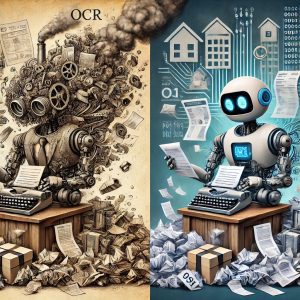April 18, 2025
Why OCR Is Not AI…And Why It Matters
Let’s get one thing straight: OCR is not AI. And if your mortgage tech stack still pretends that it is, you’ve got a bigger problem than high rates and low volumes.
And if your document data extraction vendor has slapped an AI badge on their platform, you might want to be skeptical as to whether they have really abandoned their out-dated OCR.
Optical Character Recognition (OCR) has been the workhorse behind most document automation claims in mortgage tech for the past decade. It sounds impressive until you realize that most OCR tools are built on the same crusty, open-source libraries that date back to the early 2000s.
So What Is OCR, Really?
OCR is essentially pattern recognition software. It looks at an image, guesses what characters are on it, and converts them into text. That’s it. OCR doesn’t know what a pay stub is. It doesn’t know a W2 from a banana. And it certainly doesn’t understand that different lenders calculate income differently based on investor overlays.
OCR is like a toddler pointing at random things and calling everything “doggy.” Cute? Maybe. Reliable? Not on your life.
The Open Secret of OCR Tools
Here’s the thing mortgage execs rarely hear: the majority of OCR engines—open-source or otherwise—are built on the same underlying tech:
- Tesseract (maintained by Google): Widely used, decent accuracy with structured text, but struggles with skewed images or handwritten text. (source)
- Abbyy FineReader: Commercial, marginally better, but still not AI.
- Google Vision API / Amazon Textract: Cloud OCR as a service. Fast, scalable, and marginally better at layout detection, but again—just text extraction, no understanding.
If you don’t already know, almost every document vendor you’ve worked with over the past 20+ years has simply employed all three of these libraries and taken a “majority rules” approach to providing you what is “reliable” data. The key word here is extraction—not interpretation, not understanding, and certainly not decision-making. That’s where real AI steps in.
AI Isn’t Just Smarter OCR—It’s a Different Species
Microsoft’s Azure AI Document Intelligence (formerly Form Recognizer) doesn’t play in the sandbox with traditional OCR tools. It uses deep neural networks to not only extract text, but also to understand document structure and identify document types.
Want to know if a borrower uploaded a bank statement or a pizza receipt? Azure AI doesn’t just read the text—it classifies the document with a confidence score. That means it can detect and sort 200+ document types like W-2s, pay stubs, and 1003s—even if they look wildly different depending on the lender, LOS, or scan quality.
Even better? Azure AI can extract specific fields with contextual understanding. It knows that “Net Pay” isn’t the same as “Gross Income,” and it can tell you where those values are with a high degree of confidence.
This isn’t your dad’s OCR. This is structured intelligence layered on document data.
More importantly, document AI intelligence is actually constantly improving. Unlike the OCR libraries which have not fundamentally improved for over a decade, we see AI tools are getting more accurate, faster at learning, and cheaper literally every day.
Why This Matters for Mortgage Lenders
Let’s bring this home. If your LOS or doc automation platform is still reliant on OCR, here’s what you’re missing out on:
- Document Classification: OCR doesn’t do this. That’s why your OCR-based vendor struggles every time you ask for a new document to be recognized. Vallia DocFlow, powered by Azure AI, does. It can identify if a file is a pay stub, a gift letter, or an obscure DPA certification—with 269+ types trained and counting.
- Field-Level Validation: OCR gives you a blob of text. Vallia DocFlow lets you extract, compare, and even resolve discrepancies automatically between doc data and your other systems. And we’ve aligned a data extraction layer that aligns to mortgage…not just some generalized data payload that you have to figure out on your own.
- Speed and Accuracy: Vallia can process massive loan packages (600+ pages) in under a minute—splitting, classifying, extracting, and validating with confidence scoring and error handling built in.
- Customization and Learning: Training new document types in Vallia takes less than an hour. Five samples and you’re off to the races. That’s because Microsoft’s AI models are pre-trained on massive datasets and easily extended.
TL;DR: OCR is Table Stakes. AI is the Whole Damn Casino.
If your doc automation vendor is still trying to pass OCR off as AI, it’s time to call their bluff. True AI understands documents, adapts to new formats, validates against source systems, and drives automation without human babysitting.
Brimma’s Vallia DocFlow, powered by Microsoft Azure AI, isn’t a prettier OCR. It’s the future of document intelligence—and if your current tech can’t do what was just described above, it’s time to upgrade or get out of the way.
Let me know if you’d like to adapt this into a downloadable resource or use it in your sales enablement materials. We could also spin it into a visual infographic showing OCR vs. AI head-to-head.


